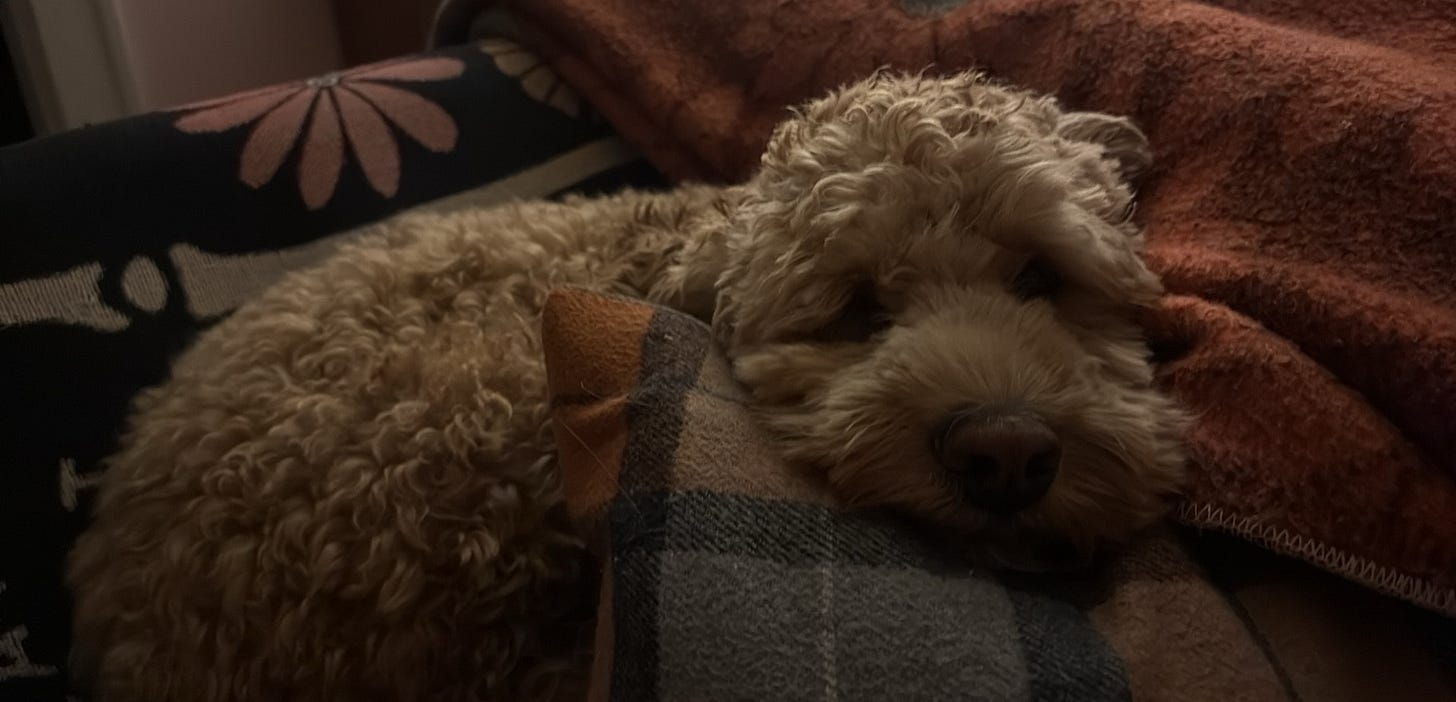On Reality & Dreaming
It’s 3am, all the windows in the house are black. I can’t quite fall asleep so I creep downstairs to lay on the couch. It’s peaceful and quiet. One of my dogs soon joins me. He is big and confident and curly-haired, still a puppy. He lays beside me and is soon snoring gently. I watch him with soft eyes and contemplate the nature of dreams and reality.
According to oneirologists Domhoff and Schneider, dreams can be defined as follows:
“[Dreams are] a report of a memory of a cognitive experience that happens under the kinds of conditions that are most frequently produced in a state called sleep.”
There are some key components to consider with this definition:
We can remember dreams occasionally upon waking
We believe we experience dreams through our senses; they are actually a purely cognitive experience
We usually dream while we are asleep
Perhaps it is the late hour; the more I read this definition, the more I begin to question the separateness of dreaming and waking states. I think there’s a chance there are many opportunities for cross-over between them. The most commonly experienced of these is the ability to recall dreams upon waking.
The clarity with which we remember dreams varies depending on a couple of different factors. Dreams are thought to intensify over the course of the night in terms of imagery, colors, and emotions. The final dreams of the night tend to be the most emotional and the most likely to be recalled upon waking. Dreamers can recall dreams about 50% of the time when awakened earlier in the night; towards morning, recall can climb to almost 99%. The ability to recall our dreams tends to drop off after waking, as the time since dreaming increases.
Our experiences during waking hours also tend to be largely forgotten over time, according to a concept in learning called the Forgetting Curve. New information is forgotten at a rate of 50% within 1 hour of learning; up to 90% is lost within a week. This is a natural consequence of the data-density of human experience and the limitations of our brain. For most of us, it isn’t possible to remember everything.

My other dog joins me downstairs. His personality is more timid, more anxious. He licks my leg briefly as if we are reassuring each other of this change in nighttime routine. The dog eventually settles down, high on a couch cushion. His dreams are more fitful, perhaps more fearful. Do his dreams reflect his reality?
Most of our dreams are authentic dreams, which are a relatively faithful reflection of the dreamer’s actual thoughts and experiences from waking life. Our dreams do actually reflect our lived realities.
The goal of this type of dreaming is to rehearse lived experiences and reinforce thought and behaviour patterns through a process called synaptic efficacy maintenance. This process happens with high fidelity for dreams of relatively recent experiences; over time, however, this process tends to accumulate “errors”.
Illusory dreams are the result of experiencing these synaptic efficacy maintenance errors in sleep. They have content that is otherworldly, impossible, or nonsensical in nature. This type of dreaming is consistent with the brain patterns of those experiencing delusions in some mental disorders.
We can imagine that we remember as much about our dreams as we do about our waking life, that reality bleeds easily into dreams, and dreams into reality. What then is the difference between these two states? Could there be just one continuous state that we all inhabit?
Perhaps our initial definition is too narrow.
Perhaps all of us are walking this Earth as living dream machines and the world is actually quite a bit more mystical than we’ve come to believe.
My head nods gently on my chest and I briefly succumb to that sweet restful respite called sleep.
It is just before dawn, the windows frame images of an early fall morning. It is peaceful but no longer quiet: I can hear birds begin to chirp and sing in the sweep of lilacs that line one side of the yard. I could creep back upstairs and get cozy under the covers of my bed; my dogs would wake and follow. Instead I toddle over to the coffee maker, dreaming of what the day will bring.
To support my work on Substack, consider becoming a free or paid subscriber.
If you enjoyed this post, consider buying me a coffee.

